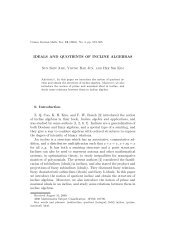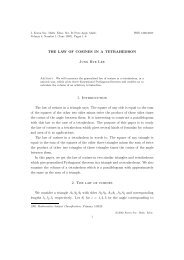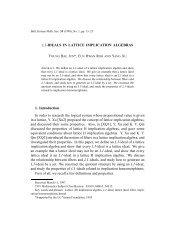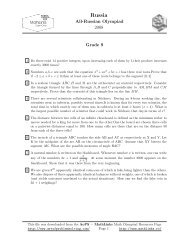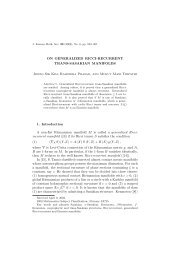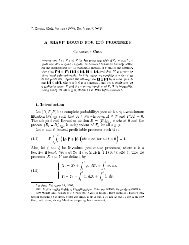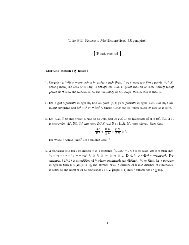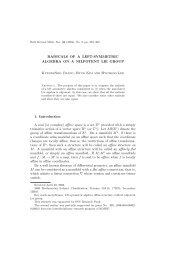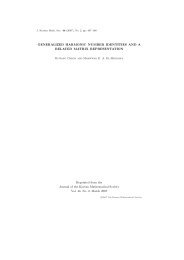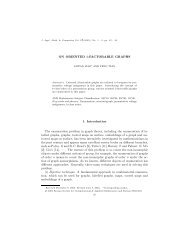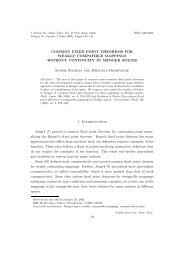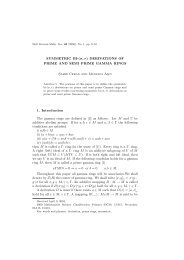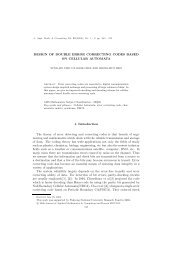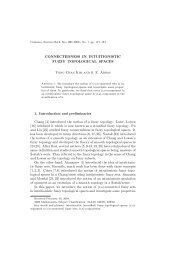MAXIMAL MONOTONE OPERATORS IN THE ONE DIMENSIONAL ...
MAXIMAL MONOTONE OPERATORS IN THE ONE DIMENSIONAL ...
MAXIMAL MONOTONE OPERATORS IN THE ONE DIMENSIONAL ...
You also want an ePaper? Increase the reach of your titles
YUMPU automatically turns print PDFs into web optimized ePapers that Google loves.
J. Korean Math. Soc. 34 (1997), No. 2, pp. 371–381<br />
<strong>MAXIMAL</strong> <strong>MONOT<strong>ONE</strong></strong> <strong>OPERATORS</strong><br />
<strong>IN</strong> <strong>THE</strong> <strong>ONE</strong> <strong>DIMENSIONAL</strong> CASE<br />
SANGHO KUM ∗<br />
ABSTRACT. Our basic concern in this paper is to investigate some geometric<br />
properties of the graph of a maximal monotone operator in the one dimensional<br />
case. Using a well-known theorem of Minty, we answer S. Simons’ questions<br />
affirmatively in the one dimensional case. Further developments of these results<br />
are also treated. In addition, we provide a new proof of Rockafellar’s<br />
characterization of maximal monotone operators on R: every maximal monotone<br />
operator from R to 2 R is the subdifferential of a proper convex lower<br />
semicontinuous function.<br />
1. Introduction and Preliminaries<br />
The maximal monotonicity of the subdifferential of a proper convex lower<br />
semicontinuous function due to Rockafellar [6] is one of the fundamental<br />
theorems in convex analysis. Many authors [1, 11] have provided independent<br />
proofs for this theorem. Recently, Simons [8-10] has generalized this result<br />
in several directions and has given very elementary and simple proofs which<br />
do not depend on any difficult results. One of the generalizations [9, Theorem<br />
6.1] is as follows; Let E be a real Banach space and E ∗ its dual space. Let<br />
ψ : E → R ∪{∞}be a proper convex lower semicontinuous function, and<br />
∂ψ be the subdifferential of ψ. IfQis a nonempty weakly compact convex<br />
subset of E, q ∗ ∈ E ∗ and, for all (z, z ∗ ) ∈ Gr(∂ψ), there exists q ∈ Q such<br />
that 〈z − q, z ∗ − q ∗ 〉≥0then<br />
(Q×{q ∗ })∩Gr(∂ψ) ≠ ∅.<br />
At the same time, he asked whether the corresponding result is true for general<br />
maximal monotone operators: let M be a maximal monotone opreator from E<br />
Received May 16, 1996.<br />
1991 Mathematics Subject Classification: 47H05, 47H99.<br />
Key words and phrases: maximal monotone operator, subdifferential of a convex function,<br />
cyclically monotone.<br />
* Supported in part by the Post-Doctoral Fellowship of KOSEF and in part by GARC-KOSEF<br />
in 1995.
372 Sangho Kum<br />
to 2 E∗ ,andGr(M) be the graph of M in E × E ∗ .LetQbe a nonempty weakly<br />
compact convex subset of E, q ∗ ∈ E ∗ such that (Q ×{q ∗ })∩Gr(M) =∅.<br />
Does there necessarily exist (z, z ∗ ) ∈ Gr(M) such that for all q ∈ Q,<br />
〈z − q, z ∗ − q ∗ 〉 < 0.<br />
Our basic concern in this paper is to investigate some geometric properties<br />
of the graph of a maximal monotone operator in the one dimensional case. In<br />
section 2, we answer Simons’ question affirmatively in the one dimensional<br />
case E = R. Moreover, we verify that this result remains true for the<br />
case where the point q ∗ is replaced by a nonempty compact convex set Q ∗ .<br />
This also answers in the one dimensional case another question posed by<br />
Simons [9] for general Banach space. After this, we give a characterization<br />
of maximal monotone operators in R: every maximal monotone operator from<br />
R to 2 R is cyclically monotone, hence is the subdifferential of a proper convex<br />
lower semicontinuous function by means of Rockafellar [6]. Actually, this<br />
characterization was first proved by Rockafellar [7, Theorem 24.3, p.232]. His<br />
proof was based upon some properties of the one-sided directional derivative<br />
of a proper convex lower semicontinuous function and a characterization of<br />
the graph of a maximal monotone operator as a complete non-decreasing<br />
curve [7, Sections 23 and 24]. However, we will provide a simpler approach<br />
to that characterization. Section 3 deals with a refinement of the two theorems<br />
in the previous section.<br />
Let M : R → 2 R be maximal monotone and D(M) be the effective<br />
domain of M. IfD(M)is a singleton {a}, thenM(x)=(−∞, ∞) if x = a,<br />
M(x) =∅otherwise. Recall that Minty’s theorem [3] says: let H beafinite<br />
dimensional Hilbert space, with real or complex scalars, and M : H → 2 H<br />
be maximal monotone. Then D(M) is almost convex in the sense that D(M)<br />
contains the relative interior of the convex hull coD(M) of D(M). So, in the<br />
case where D(M) contains at least two points, using Minty’s result [3], we<br />
know that D(M) is a convex subset of R. Indeed, let a, b ∈ D(M). Clearly,<br />
(a, b) is contained in the relative interior of coD(M). SinceD(M)is almost<br />
convex, the open interval (a, b) is contained in D(M), so is the closed interval<br />
[a,b] as desired. Hence D(M) is of one of the forms [a, b], (a,b), (a, b],<br />
[a, b). Moreover, Gr(M) is path-connected by virtue of another theorem of<br />
Minty [4]. Since M is monotone, we have<br />
(1.1) sup M(x 1 ) ≤ inf M(x 2 ) whenever x 1 < x 2 , x 1 , x 2 ∈ D(M).
Maximal monotone operators in the one dimensional case 373<br />
It is easily seen that M can be represented by<br />
⎧<br />
[infM(x), sup M(x) ] ifa < x < b<br />
⎪⎨<br />
(−∞, sup M(a) ] if x = a<br />
M(x) =<br />
[infM(b), ∞) if x = b<br />
⎪⎩<br />
∅<br />
otherwise.<br />
In the above representation, we follow the usual convention<br />
sup ∅=−∞, inf ∅=∞.<br />
Recall that a set-valued map M : E → 2 E∗ is said to be cyclically monotone<br />
provided<br />
n∑<br />
〈x k − x k−1 , xk ∗ 〉≥0<br />
k=1<br />
whenever n ≥ 2andx 0 ,x 1 ,··· ,x n ∈ E, x n = x 0 ,andx ∗ k ∈M(x k), k =<br />
1, 2, ··· ,n.<br />
2. Applications of a theorem of Minty<br />
<strong>THE</strong>OREM 1. Let M : R → 2 R be maximal monotone and Q be a<br />
nonempty compact convex subset of R, q ∗ ∈ R such that (Q ×{q ∗ })∩<br />
Gr(M) =∅. Then there exists (z, z ∗ ) ∈ Gr(M) such that<br />
(2.1) 〈z − q, z ∗ − q ∗ 〉 < 0 for all q ∈ Q.<br />
Proof. Since Q = [a, b] for some a, b ∈ R, a ≤ b, andq ∗ /∈M(Q),<br />
there exist (z 1 , z1 ∗) and (z 2, z2 ∗ ) ∈ Gr(M) such that<br />
(2.2) 〈z 1 − a, z1 ∗ − q∗ 〉 < 0and〈z 2 −b, z2 ∗ −q∗ 〉 q∗ or z 2 > b, z2 ∗ < q∗ .<br />
Suppose the contrary. By (2.2), we have z 1 > a, z1 ∗ < q∗ and z 2 < b, z2 ∗ ><br />
q ∗ ,soz1 ∗
374 Sangho Kum<br />
<strong>THE</strong>OREM 2. Let M : R → 2 R be maximal monotone and Q 1 = [a, b], Q 2 =<br />
[c, d] be two closed intervals such that<br />
(Q 1 × Q 2 ) ∩ Gr(M) =∅.<br />
Then there exists (z, z ∗ ) ∈ Gr(M) such that<br />
〈z − q, z ∗ − q ∗ 〉 < 0 for all (q, q ∗ ) ∈ Q 1 × Q 2 .<br />
Proof. Since (Q 1 ×{c})∩Gr(M) = ∅, it follows from the proof of<br />
Theorem 1 that there exists (z 1 , z1 ∗) ∈ Gr(M) such that either z 1 < a, z1 ∗ > c<br />
or z 1 > b, z1 ∗ < c. Similarly, because (Q 1 ×{d})∩Gr(M) =∅,we<br />
see that there exists (z 2 , z2 ∗) ∈ Gr(M) such that either z 2 < a, z2 ∗ > d or<br />
z 2 > b, z2 ∗ < d. We claim that at least one of the two possibilities<br />
(2.4) z 1 > b, z ∗ 1 < c or z 2 < a, z ∗ 2 > d<br />
must be true. If not, z 1 < a, z1 ∗ > c and z 2 > b, z2 ∗<br />
z 1 < a ≤ b < z 2 ,wehave<br />
< d. Since<br />
(2.5) c < z ∗ 1 ≤ z∗ 2 < d<br />
by (1.1). Applying Minty’s theorem [3] again to the domain D(M), we know<br />
that D(M) contains [z 1 , z 2 ], hence contains [a, b] = Q 1 . Moreover,<br />
(2.6) M(q) ⊂ [z ∗ 1 , z∗ 2 ] ⊂ [c, d] = Q 2 for all q ∈ Q 1 .<br />
(The first inclusion comes from (1.1) and the second one from (2.5).) But the<br />
relation (2.6) obviously contradicts the assumption (Q 1 × Q 2 )∩ Gr(M) =∅.<br />
Thus (2.4) is true. Each case of the two possibilities in (2.4) clearly implies<br />
the theorem.<br />
□<br />
REMARK. As mentioned in the introduction, Theorem 2 answers in the<br />
one dimensional case another question posed by Simons [9, Remarks and<br />
Problems, p.1387] for general Banach space.<br />
<strong>THE</strong>OREM 3. Let M : R → 2 R be maximal monotone. Then M is<br />
cyclically monotone, hence is the subdifferential of a proper convex lower<br />
semicontinuous function.
Maximal monotone operators in the one dimensional case 375<br />
Proof. If D(M) is a singleton {a}, M is represented by<br />
{ (−∞, ∞) if x = a<br />
M(x) =<br />
∅ otherwise.<br />
In this case, M is clearly cyclically monotone, and the subdifferential of the<br />
proper convex lower semicontinuous function ψ : R → R ∪{∞}defined by<br />
{ k if x = a<br />
ψ(x) =<br />
∞ otherwise,<br />
where k is a real number. Now we assume that D(M) contains at least two<br />
points. Let n ≥ 2andx 0 , x 1 ,··· , x n ∈ R, x n = x 0 ,and xk ∗ ∈ M(x k), k =<br />
1, 2, ··· , n. Since the x k ’s are not necessarily distinct, it may be true that<br />
for some 0 ≤ i < j ≤ n, x i = x j and x i+1 , ··· , x j are distinct. In this case,<br />
x i , x i+1 , ··· , x j is called a cycle. We put S 0 = ∑ n<br />
k=1 〈x k − x k−1 , xk ∗〉.Then<br />
S 0 =S 1 +R 1 where S 1 = ∑ j<br />
k=i+1 〈x k − x k−1 , xk ∗〉 and R 1 is the remainder<br />
part. Observe that R 1 is the same type of summation as S 0 except R 1 may be<br />
a cycle. Anyway, by recursion, we have<br />
m∑<br />
S 0 =<br />
S k<br />
k=1<br />
where each S k is the corresponding sum of a cycle. So we may assume<br />
without loss of generality that x 0 , x 1 , ··· , x n is a cycle. Then we can<br />
select a monotone function f : D(M) → R such that f (x) ∈ M(x) for all<br />
x ∈ D(M), and f(x k )=xk ∗ , k=1, 2,··· , n.SinceD(M)is an interval,<br />
f is integrable on D(M). For each k, wehave<br />
k=1<br />
f(x k )(x k − x k−1 ) ≥<br />
k=1<br />
∫ xk<br />
x k−1<br />
f (t)dt<br />
since f is monotone. Hence<br />
n∑<br />
n∑<br />
〈x k − x k−1 , xk ∗ 〉= f(x k )(x k − x k−1 )<br />
≥<br />
=<br />
n∑<br />
k=1<br />
∫ x0<br />
x 0<br />
= 0.<br />
∫ xk<br />
x k−1<br />
f (t)dt<br />
f (t)dt
376 Sangho Kum<br />
The second part of the theorem directly follows from Rockafellar’s result [6,<br />
Theorem B].<br />
□<br />
As a direct consequence of Theorem 3, we get the following.<br />
COROLLARY. Let M : R → 2 R be monotone.<br />
monotone.<br />
Then M is cyclically<br />
Proof. By Zorn’s lemma, M can be extended to a maximal monotone<br />
operator M. It follows from Theorem 3 that M is cyclically monotone, hence<br />
M is cyclically monotone.<br />
REMARKS. 1. Theorem 3 implies that there is only one kind of maximal<br />
monotone operators, namely, the subdifferential of a proper convex lower<br />
semicontinuous function in R. However, Theorem 3 does not hold even in<br />
R 2 . As shown in Phelps [5, Examples 2.21, p.26], the linear map in R 2<br />
defined by T (x 1 , x 2 ) = (x 2 , −x 1 ) is maximal monotone, but not cyclically<br />
monotone.<br />
2. Due to Theorem 3, we observe that Simons’ result [9, Theorem 6.1] already<br />
contains the answer to his own question [9, Remarks and Problems, p.1387]<br />
in the one dimensional case. To get the result in general Banach spaces,<br />
Simons used the Ekeland variational principle [2] and Mazur-Orlicz version<br />
of the Hahn-Banach theorem.<br />
3. Further developments<br />
We begin with the following result which holds for general Banach spaces.<br />
PROPOSITION 4. Let f and g be proper convex lower semicontinuous<br />
functions on a Banach space E such that D(∂g) = E. LetQbe a nonempty<br />
weakly compact convex subset of E. If for each (z, z ∗ ) ∈ Gr(∂ f ), there<br />
exists (q, q ∗ ) ∈ Gr(−∂g) such that<br />
q ∈ Q and 〈z − q, z ∗ − q ∗ 〉≥0.<br />
Then<br />
(Q × E ∗ ) ∩ Gr(∂ f ) ∩ Gr(−∂g) ≠ ∅.
Maximal monotone operators in the one dimensional case 377<br />
Proof. Let (x, x ∗ ) ∈ Gr(∂ f + ∂g). Thenx ∗ =u ∗ +v ∗ , where (x, u ∗ ) ∈<br />
Gr(∂ f ) and (x,v ∗ ) ∈ Gr(∂g). By assumption there exists (q, q ∗ ) ∈<br />
Gr(−∂g) such that<br />
(4.1) q ∈ Q and 〈x − q, u ∗ − q ∗ 〉≥0.<br />
Since (x,v ∗ ), (q, −q ∗ ) ∈ Gr(∂g),wehave<br />
〈x−q,v ∗ +q ∗ 〉=〈x−q,v ∗ −(−q ∗ )〉≥0.<br />
Combining with (4.1), we obtain<br />
〈x − q, x ∗ 〉=〈x−q,u ∗ +v ∗ 〉=〈x−q,u ∗ −q ∗ 〉+〈x−q,v ∗ +q ∗ 〉≥0.<br />
So we have proved: for (x, x ∗ ) ∈ Gr(∂ f + ∂g), there exists q ∈ Q such that<br />
〈x − q, x ∗ 〉≥0.<br />
From the sum formula [5, Theorem 3.16, p.47], ∂( f + g) = ∂f + ∂g.Now<br />
apply Simons’ theorem [9, Theorem 6.1] to the subdifferential ∂( f + g) =<br />
∂f +∂g (with q ∗ = 0): there exists q ∈ Q such that (q, 0) ∈ Gr(∂( f + g)).<br />
This gives the desired result.<br />
□<br />
Actually, we can recover Simons’ theorem [9, Theorem 6.1] from Proposition<br />
4, which implies that two results are equivalent. For the sake of<br />
completeness, we state and prove Simons’ theorem.<br />
<strong>THE</strong>OREM. (Simons [9, Theorem 6.1]) Let f : E → R ∪{∞}be a proper<br />
convex lower semicontinuous function, and ∂ f be the subdifferential of f .If<br />
Qis a nonempty weakly compact convex subset of E, q ∗ ∈ E ∗ and, for all<br />
(z, z ∗ ) ∈ Gr(∂ f ), there exists q ∈ Q such that 〈z − q, z ∗ − q ∗ 〉≥0then<br />
(Q ×{q ∗ })∩Gr(∂ f ) ≠ ∅.<br />
Proof. Take the function g ≡−q ∗ in Proposition 4. Then it follows<br />
from the assumption that for each (z, z ∗ ) ∈ Gr(∂ f ), there exists (q, q ∗ ) ∈<br />
Gr(−∂g) such that<br />
q ∈ Q and 〈z − q, z ∗ − q ∗ 〉≥0<br />
because −∂g(x) = q ∗ for every x ∈ E. By Proposition 4<br />
(Q ×{q ∗ })∩Gr(∂ f ) = (Q × E ∗ ) ∩ Gr(∂ f ) ∩ Gr(−∂g) ≠ ∅,<br />
which completes the proof.<br />
In one dimensional case, we can rewrite Proposition 4 as follows.<br />
□
378 Sangho Kum<br />
<strong>THE</strong>OREM 5. Let M and N : R → 2 R be maximal monotone operators<br />
such that D(N) = R. LetQbe a nonempty compact convex subset of R. If<br />
for each (z, z ∗ ) ∈ Gr(M), there exists (q, q ∗ ) ∈ Gr(−N) such that<br />
q ∈ Q and 〈z − q, z ∗ − q ∗ 〉≥0.<br />
Then<br />
(Q × R) ∩ Gr(M) ∩ Gr(−N) ≠ ∅.<br />
Proof. Directly from Theorem 3.<br />
□<br />
As a special case of Theorem 5, we have the following.<br />
COROLLARY. Let M : R → 2 R be maximal monotone, and L be a line<br />
segment joining two points (a, b) and (c, d) in R 2 whose slope (d −b)/(c−a)<br />
is less than 0. Assume that L ∩ Gr(M) =∅. Then there exists (z, z ∗ ) ∈<br />
Gr(M) such that<br />
〈z − q, z ∗ − q ∗ 〉 < 0 for all (q, q ∗ ) ∈ L.<br />
Proof. Taking −N the straight line through two points (a, b) and (c, d) in<br />
Theorem 5, we get the result.<br />
□<br />
LEMMA 6. Let L be a line segment joining two points (a, b) and (c, d) in<br />
R 2 whose slope (d − b)/(c − a) is real and greater than 0. (We may assume<br />
a < c.) Then there exists a maximal monotone operator M : R → 2 R such<br />
that L ∩ Gr(M) =∅and any point (z, z ∗ ) ∈ Gr(M) does not satisfy the<br />
inequality<br />
〈z − q, z ∗ − q ∗ 〉 < 0 for all (q, q ∗ ) ∈ L.<br />
Proof. Define M : R → 2 R by<br />
⎧<br />
d−b<br />
(x − a) + d<br />
c−a<br />
⎪⎨<br />
(−∞, b]<br />
M(x) =<br />
[d, ∞)<br />
⎪⎩<br />
∅<br />
if 2a − c < x < a<br />
if x = 2a −c<br />
if x = a<br />
otherwise.<br />
Then M is a desired maximal monotone operator.<br />
□
Maximal monotone operators in the one dimensional case 379<br />
REMARK. We can take another M : R → 2 R as follows;<br />
⎧<br />
d−b<br />
(x − c) + b if c < x < 2c − a<br />
c−a<br />
⎪⎨ (−∞, b] if x = c<br />
M(x) =<br />
[d, ∞) if x = 2c − a<br />
⎪⎩<br />
∅<br />
otherwise.<br />
Combining Theorem 1, the Corollary of Theorem 5 and Lemma 6, we<br />
have the following.<br />
<strong>THE</strong>OREM 7. Let L be a line segment joining two points (a, b) and (c, d)<br />
in R 2 . The slope of L is ≤ 0 if and only if for each maximal monotone<br />
operator M : R → 2 R with L ∩ Gr(M) =∅, there exists (z, z ∗ ) ∈ Gr(M)<br />
such that<br />
〈z − q, z ∗ − q ∗ 〉 < 0 for all (q, q ∗ ) ∈ L.<br />
As a direct consequence of Lemma 6 and the remark following, we get the<br />
following.<br />
<strong>THE</strong>OREM 8. Let P be the convex hull of a finite subset {x 1 , x 2 , ··· ,x n }<br />
in R 2 . (We may assume that each x i is an extreme point of P and the set of<br />
line segments {x i x i+1 } n i=1 consist of the edges of P. Here, x n+1 = x 1 .) If we<br />
have at least one 1 ≤ i ≤ n such that the slope of x i x i+1 is real and greater<br />
than 0, then there exists a maximal monotone operator M : R → 2 R such<br />
that P ∩ Gr(M) =∅and for any (z, z ∗ ) ∈ Gr(M),<br />
is not true.<br />
〈z − q, z ∗ − q ∗ 〉 < 0 for all (q, q ∗ ) ∈ P<br />
REMARK. Theorem 8 tells us that the conclusion “there exists (z, z ∗ ) ∈<br />
Gr(M) such that<br />
〈z − q, z ∗ − q ∗ 〉 < 0forall(q,q ∗ )∈P."<br />
does depend on the shape of the given compact convex set P. Hence it<br />
is not unreasonable to guess that Simons’ question [9] for general maximal<br />
monotone operators on a Banach space may have a negative answer.<br />
ACKNOWLEDGEMENT. The author expresses deep thanks to Professor S.<br />
Simons for his valuable comments and suggestions. In particular, Proposition<br />
4 was suggested by Professor S. Simons.
380 Sangho Kum<br />
References<br />
[1] J. M. Borwein, A note on ɛ-subgradients and maximal monotonicity, Pacific. J. Math. 103<br />
(1982), 307-314.<br />
[2] I. Ekeland, Nonconvex minimization problems, Bull. Amer. Math. Soc. 1 (1979), 443-474.<br />
[3] G. J. Minty, On the maximal domain of a monotone function, Michigan Math. J. 8 (1961),<br />
135-137.<br />
[4] G. J. Minty, Monotone (nonlinear) operators in Hilbert space, Duke Math. J. 29 (1962),<br />
341-346.<br />
[5] R. R. Phelps, Convex Functions, Monotone Operators and Differentiability, Lecture Notes<br />
in Math. 1364, Springer-Verlag. Second Edition, 1993.<br />
[6] R. T. Rockafellar, On the maximal monotonicity of subdifferential mappings, Pacific J. Math.<br />
33 (1970), 209–216.<br />
[7] R. T. Rockafellar, Convex Analysis, Princeton University Press, Princeton, N. J., 1970.<br />
[8] S. Simons, Subdifferentials are locally maximal monotone, Bull. Australian Math. Soc. 47<br />
(1993), 465-471.<br />
[9] S. Simons, Subtangents with controlled slope, Nonlinear Analysis TMA 22 (1994), 1373-<br />
1389.<br />
[10] S. Simons, Swimming below icebergs, Set-Valued Analysis 2 (1994), 327-337.<br />
[11] P. D. Taylor, Subgradients of a convex function obtained from a directional derivative,<br />
Pacific J. Math. 44 (1973), 739-747.<br />
Department of Applied Mathematics<br />
Korea Maritime University<br />
Pusan 606-791, Korea<br />
E-mail: kum@hanara.kmaritime.ac.kr



